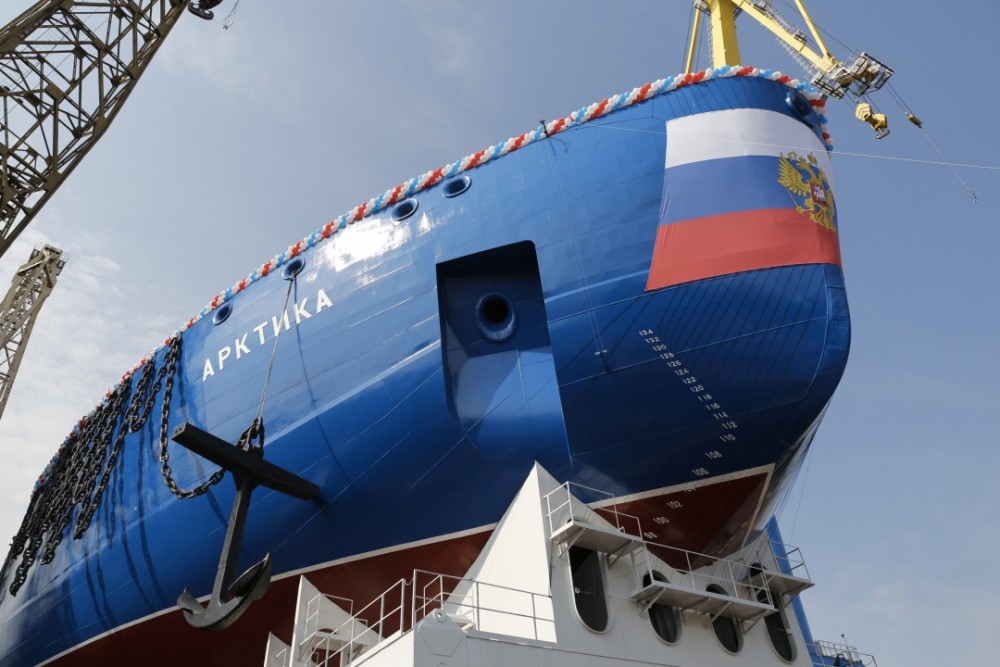
The system built to manage Russia’s nuclear legacy is crumbling, our new report shows
Our op-ed originally appeared in The Moscow Times. For more than three decades, Russia has been burdened with the remains of the Soviet ...
News

Publish date: August 7, 2019
News
Russia has said it will build two new nuclear icebreakers in a bid to make a rapidly melting trade route through the Arctic accessible to shipping traffic on a year round basis.
The announcement came on July 10 when Atomflot, which runs Russia’s nuclear icebreaker fleet, posted an official tender for two new nuclear vessels for a total price of $1.47 billion.
The new orders represent an addition to three nuclear icebreakers that Russia already has under construction, called the Arktika,” the “Sibir” and “Ural,” all of which are expected to enter service by 2022. The two new icebreakers now under tender, which will be an extension of that line, are to launch by 2024 and 2026 respectively.
These vessels of the so-called LK-60Ya type are built to enormous dimensions. Each is up to 173 meters long, and is powered by twin RITM-200 reactors, which deliver a combined 175 megawatts of power – making them the most powerful civilian vessels in the world.
It is widely expected that the Baltic Shipyard in St Petersburg – where the other three icebreakers are being built – will get the massive tender, though two other shipyards, one in Crimea and the other in the Russian Far East, are expected to bid on the project as well.
Atomflot’s new order is part of Moscow’s push to bring the Arctic under its control as climate change thins polar ice, opening a shipping corridor between Europe and Asia. The 6,000-kilometer Arctic passage, called the Northern Sea Route, is thought to lop days off more conventional shipping schedules via the Suez Canal. But icebreaking vessels are still needed to keep trade lanes open for cargo convoys for much of the year – a service for which Moscow charges shippers a hefty toll.
 The launch of the Ural nuclear icebreaker in St Petersburg
Credit: Baltic Shipyard
The launch of the Ural nuclear icebreaker in St Petersburg
Credit: Baltic Shipyard
President Vladimir Putin is betting big on the Arctic thaw, last year has ordering his government to boost shipping through the Northern Sea Route to 80 million tons a year by 2024, a fourfold uptick over current levels.
Moscow’s ministries and state corporations have promised to deliver the goods, and already some 10 percent of Russia’s total investments are in Arctic projects.
The Yamal LNG project, which went into production earlier this year, expects to ship 15.5 million tons of natural gas a year. The Yamal LNG II project, expected to open in 2023, will add another 19.8 billion tons.
Yet more traffic through the Northern Sea Route will be accounted for by oil – much of it from pipelines funneled from Central Siberia to Arctic seaports specifically to fulfill Putin’s increased cargo demands.
But it’s not just traffic from fossil fuel industries that Moscow is banking on. Earlier this year, Russian Parliament adopted legislation giving Rosatom a monopoly over managing access to the Northern Sea Route through its icebreakers, which will chaperone foreign traffic.
The Russian government’s claim that shippers need Moscow’s permission to pass through the route has irked some. US Secretary of State Mike Pompeo has called the Kremlin’s intentions to run the Northern Sea Route like a toll road “illegal.”
But others, like China, are keen to play by Moscow’s rules – in exchange for part of the profits. Beijing, which is the largest foreign investor in Russia’s Yamal LNG project, is developing an Arctic trade strategy that has dubbed “The Polar Silk Road.” Shippers in South Korea and Denmark have conducted pilot voyages through the Northern Sea Route as well.
Moscow has meanwhile backed up its claims as the Arctic’s traffic cop with military might. Ten disused Arctic military airfields have been reopened, and 13 more are being built. The bases cover almost the entire coastline and are, if required, ready to protect or disrupt any traffic along the North Sea Route.
All of this is part of a bigger bet Russia is making on climate change. According to data from NASA, Arctic ice has shrunk by 12.8 percent a year on average since 1979. Last year’s ice cover was 42 percent lower than 1980. By some estimates, the entire Polar Region could be largely ice-free by 2050.
While most nations with access to the Arctic have been shy about capitalizing on global warming to commercialize the pristine polar environment, Putin has not. The Kremlin strategy suggests that by the time climate change helps make the Northern Sea Route navigable all year, Russia will have full control of any traffic on the route, and will be actively exploiting it for its own commodity exports, shortening the shipping path to Asia.
How that approach will affect the rest of the world, however, is not in dispute. According to a study published by the science journal Nature, Russia’s current climate policies would push up global temperatures by more than 5 degrees Celsius — at least 3 degrees higher than the limit climate scientists are aiming for.
Russia is currently operating four other nuclear icebreakers: The “Yamal,” the “50 Let Pobedy,” the“Taymyr,” and “Vaygash.”

Our op-ed originally appeared in The Moscow Times. For more than three decades, Russia has been burdened with the remains of the Soviet ...

The United Nation’s COP30 global climate negotiations in Belém, Brazil ended this weekend with a watered-down resolution that failed to halt deforest...

For more than a week now — beginning September 23 — the Zaporizhzhia Nuclear Power Plant (ZNPP) has remained disconnected from Ukraine’s national pow...

Bellona has taken part in preparing the The World Nuclear Industry Status Report 2025 and will participate in the report’s global launch in Rome on September 22nd.